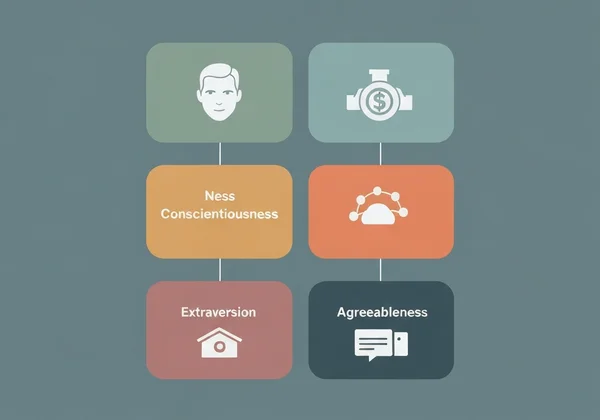Neuroticism Test: Understand Your Emotional Stability and Personality
Have you ever found yourself worrying excessively about a minor mistake, feeling overwhelmed by stress that others seem to handle with ease, or experiencing frequent shifts in your mood? If so, you're not alone. These experiences are closely linked to a fundamental personality trait known as Neuroticism. But what is it, really? And more importantly, what is a neuroticism test and how can understanding your score empower you?
This guide will demystify neuroticism, exploring its place in psychology, how it manifests in daily life, and how you can gain valuable self-insight. The first step to managing your emotional responses is understanding them, and that journey can begin today. For a personalized look into your own emotional patterns, you can take our test on our homepage.

Defining Neuroticism: More Than Just "Being Anxious"
While often used interchangeably with "anxiety" or "moodiness," neuroticism is a much broader and more foundational personality trait. It reflects an individual's tendency to experience negative emotions, including anxiety, worry, fear, anger, frustration, envy, jealousy, guilt, and sadness. It’s not about whether you feel these emotions—everyone does—but rather about their frequency, intensity, and duration.
Someone with a higher level of neuroticism might react more strongly to stressors and find it harder to return to an even keel after an upsetting event. Conversely, a person low in neuroticism tends to be more emotionally stable and resilient.
The Big Five Model: Where Neuroticism Fits In
To properly understand this trait, it helps to see where it comes from. Neuroticism is one of the pillars of the Big Five model, a widely respected and scientifically validated framework for describing human personality. The five core traits are:
- Openness to Experience: (curious vs. cautious)
- Conscientiousness: (organized vs. easy-going)
- Extraversion: (outgoing vs. solitary)
- Agreeableness: (compassionate vs. challenging)
- Neuroticism: (sensitive/nervous vs. secure/confident)
Within this model, neuroticism represents a continuous spectrum, not a simple "yes or no" category.

Emotional Stability: The Other Side of the Neuroticism Spectrum
The opposite end of the neuroticism scale is often referred to as emotional stability. Individuals with high emotional stability are not emotionless; they simply have a greater capacity to remain calm and balanced under pressure. They are less prone to persistent worry, are more resilient in the face of setbacks, and generally experience a more even emotional state. Recognizing this polarity is key to understanding that this trait is about a pattern of emotional regulation, not a personal failing.
What Influences Neuroticism? Exploring Its Origins and Development
Why are some people more prone to neurotic tendencies than others? Like most psychological traits, the answer lies in a complex interplay of genetics and environment. Research shows that our personality is shaped by both our innate predispositions and our life experiences.
Nature vs. Nurture: Is Neuroticism Inherited?
Twin studies have consistently shown that there is a significant genetic component to neuroticism. If your family has a history of anxiety or mood sensitivity, you may have a higher biological predisposition to this trait. However, genes are not destiny. They create a foundation, but your environment and experiences build the structure of your personality upon it.
How Early Experiences Shape Emotional Reactivity
Your upbringing, significant life events, and learned coping mechanisms play a crucial role in shaping your level of neuroticism. A childhood environment that was unpredictable or highly critical may foster a greater tendency toward anxiety and self-doubt. Conversely, a supportive and secure environment can build a strong foundation for emotional resilience, even for those with a genetic predisposition towards higher neuroticism. Understanding your own patterns is the first step, and a free neuroticism test can offer a clear snapshot.
The Spectrum of Neuroticism: High vs. Low Scores
Since neuroticism exists on a spectrum, what does it actually look like at either end? Knowing these characteristics can help you identify where you might fall and understand your reactions to the world. A comprehensive online neuroticism test provides the most accurate measure.
Understanding a High Neuroticism Score
A high neuroticism score suggests a greater sensitivity to perceived threats and stressors in the environment. Individuals in this range might:
- Worry frequently about various aspects of life.
- Experience mood swings and feelings of irritability.
- Feel self-conscious or anxious in social situations.
- Be more prone to feelings of guilt, sadness, or anger.
- Struggle with stress management and find it difficult to relax.
While this can be challenging, it can also be associated with positive qualities, such as a greater level of preparedness, a strong sense of empathy, and a deep capacity for self-reflection.
Exploring Low Neuroticism: Traits of Emotional Resilience
On the other end, a low neuroticism score is indicative of high emotional stability. People with these traits tend to:
- Remain calm and level-headed in stressful situations.
- Experience fewer negative emotions and recover from them quickly.
- Feel secure and confident in themselves.
- Worry less and maintain an optimistic outlook.
- Be free from persistent feelings of guilt or anxiety.
This resilience is a great strength, but it's important for emotionally stable individuals to remain empathetic to the struggles of those who experience the world with more sensitivity.

The Everyday Impact of Neuroticism: Relationships, Work, and Life
Understanding your level of neuroticism isn't just an academic exercise; it has tangible effects on your daily experiences, from your closest relationships to your professional life. Recognizing these patterns can help you navigate them more effectively.
Navigating Relationships: Neuroticism and Interpersonal Dynamics
In relationships, higher neuroticism can manifest as a greater need for reassurance, a tendency to worry about the stability of the connection, or increased sensitivity to a partner's words and actions. This can lead to misunderstandings, but it can also foster deep emotional intimacy when partners learn to communicate openly about their feelings and needs. Self-awareness is the key to building healthier relationship dynamics.
Work and Career: Harnessing or Handling Neurotic Traits
At work, high neuroticism can be a double-edged sword. The tendency to worry can translate into meticulous planning and a strong ability to anticipate problems before they arise. However, it can also lead to performance anxiety, difficulty accepting constructive criticism, and workplace stress. Knowing this allows you to seek roles that leverage your strengths—like quality control or risk analysis—while developing strategies to manage stress. Discovering where you stand can help guide your career path; start your assessment to learn more.
Neuroticism vs. Anxiety & Other Conditions: Clarifying Key Differences
It is crucial to distinguish the personality trait of neuroticism from clinical mental health conditions. Our test is an educational tool for self-discovery, not a substitute for professional diagnosis.
Is Neuroticism the Same as Anxiety? A Clear Distinction
While closely related, they are not the same. Neuroticism is a broad personality trait that describes a long-term tendency to experience a range of negative emotions, with anxiety being just one of them. An anxiety disorder, on the other hand, is a clinical condition characterized by persistent, excessive fear and worry that significantly impairs daily functioning. High neuroticism can be a risk factor for developing an anxiety disorder, but many people with high neuroticism do not have a clinical condition.
Neuroticism, Autism, and ADHD: Understanding Separate Concepts
Neuroticism is sometimes confused with traits associated with Autism Spectrum Disorder (ASD) or Attention-Deficit/Hyperactivity Disorder (ADHD), but they are distinct concepts. For example, the social anxiety experienced by someone high in neuroticism is different from the social challenges related to ASD, which often stem from difficulties in interpreting social cues. Similarly, the restlessness of neuroticism differs from the core inattention and hyperactivity symptoms of ADHD. They are separate constructs and should not be conflated.
Empowering Self-Understanding: Your Next Steps in Exploring Neuroticism
Understanding neuroticism is about gaining a deeper insight into your emotional world. It’s not about labeling yourself as "good" or "bad" but about recognizing your natural tendencies and learning how to work with them. Knowing if you lean towards higher neuroticism can empower you to develop effective coping strategies, build resilience, and communicate your needs more clearly. If you have lower neuroticism, it can help you appreciate your emotional stability and better understand others.
Self-awareness is the most powerful tool for personal growth. The journey begins with a single, simple step: getting to know yourself better.

Ready to uncover your unique personality profile? Take the free neuroticism test on our homepage today and receive your instant score, along with the option for a detailed, AI-powered analysis to guide your path forward.
Your Top Questions About Neuroticism Answered
How do I know if I have high neuroticism?
The most reliable way to know is by taking a scientifically-based assessment. While signs like frequent worrying, mood swings, and high stress levels can be indicators, a structured test provides an objective score. An instrument like our big five neuroticism test is designed to measure this trait accurately.
Can you change or reduce neuroticism?
While core personality traits are relatively stable, you can absolutely learn to manage the tendencies associated with high neuroticism. Practices like mindfulness, cognitive-behavioral therapy (CBT), regular exercise, and developing healthy coping strategies can significantly improve emotional regulation and build resilience, effectively lowering the negative impact of neuroticism on your life.
What are the core Big Five traits associated with neuroticism?
Within the Big Five model, neuroticism itself is one of the five core traits. It is further broken down into facets such as anxiety, anger, depression, self-consciousness, immoderation, and vulnerability. A high score indicates a stronger presence of these facets.
How does a neurotic person typically behave?
A person high in neuroticism may behave in ways that reflect their internal emotional state. This might include seeking reassurance from others, overthinking decisions, reacting strongly to minor setbacks, and expressing worry or frustration more frequently. However, they can also be highly empathetic, creative, and conscientious.
What's the difference: am I neurotic or just anxious?
Think of it this way: anxiety is a specific emotional state of worry or fear. Neuroticism is the personality trait that makes a person more prone to experiencing anxiety (and other negative emotions) more often and more intensely. You can feel anxious without being high in neuroticism, but someone high in neuroticism is likely to feel anxious more regularly. An emotional stability test can help clarify this.